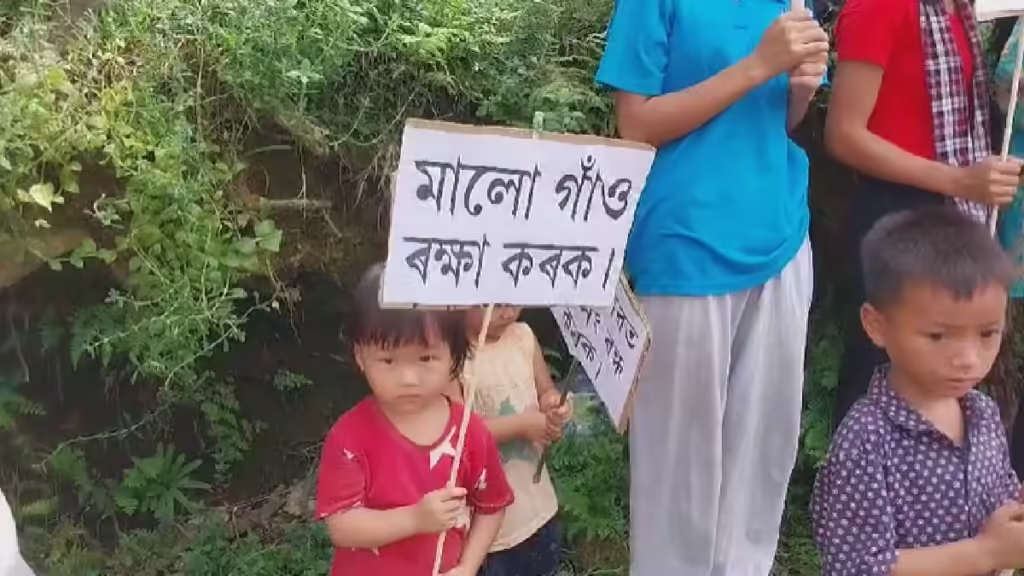In a powerful display of unity, over 500 residents of Malu Gaon gathered on Monday to protest the Assam BJP-led government’s plan to establish a coal dumping ground in their village. Joined by the All Assam Tangsa Student Union (AATSU) and the Tangsa Jatiyo Parishad, the residents held a massive dharna, voicing their concerns over the environmental and cultural implications of such a project.
The protesters expressed their deep-rooted connection to their land and heritage, emphasizing that the proposed coal dumping site poses significant threats to both their community and the environment. Leaders of the AATSU highlighted the long-term consequences of industrial activities on local ecosystems, arguing that coal dumping would not only contaminate water sources but also harm the flora and fauna that thrive in the region. The protesters carried placards bearing slogans such as “Protect Our Land” and “Save Malu Gaon,” demonstrating their commitment to preserving their environment for future generations.
The residents of Malu Gaon, many of whom rely on agriculture and fishing for their livelihoods, fear that the coal dumping ground would lead to irreversible damage to their natural resources. The village is known for its lush greenery and abundant wildlife, and the people have lived harmoniously with nature for generations. The protesters pointed out that establishing a coal dumping site would compromise the integrity of their land, jeopardizing their traditional way of life.
In addition to environmental concerns, the protesters voiced their apprehension about the potential social and health impacts of coal dumping. The presence of a coal yard could attract heavy vehicular traffic and increase pollution levels, leading to respiratory problems and other health issues among residents. AATSU leaders spoke about the importance of maintaining a healthy community and the detrimental effects that industrialization could have on public health.
The protest garnered attention from local media and social activists, amplifying the voices of the Malu Gaon residents. Many supporters from neighboring villages joined the demonstration, showcasing solidarity among the communities that share similar concerns about environmental degradation. Social media platforms buzzed with updates about the protest, with residents urging others to stand up against the coal dumping proposal. The AATSU encouraged citizens to participate in the ongoing dialogue about sustainable development and environmental protection.
As the dharna continued, local leaders reiterated their commitment to engage with government officials. They demanded that the Assam government hold discussions with community members before making any decisions about the proposed coal dumping site. The residents insisted that their voices be heard and that their cultural heritage be respected. They argued that the government should prioritize sustainable practices that support local livelihoods instead of pushing forward with projects that threaten their way of life.
The Tangsa community has a rich cultural heritage, and the protesters highlighted the importance of preserving their identity in the face of potential industrial encroachment. They called for the recognition of their rights as indigenous people and stressed the need for inclusive decision-making processes that respect the interests of local communities. The unity displayed during the protest reflected the residents’ determination to protect their land, culture, and future.
In response to the protests, local officials acknowledged the residents’ concerns and promised to look into the matter. However, community leaders remained cautious, expressing skepticism about the government’s willingness to prioritize environmental and social considerations. They vowed to continue their advocacy for sustainable development, urging the government to explore alternative solutions that align with the community’s values and aspirations.
As the day of protest drew to a close, residents left with renewed determination to safeguard their heritage. They expressed hope that their actions would resonate with decision-makers, compelling them to reconsider the proposal for a coal dumping ground in Malu Gaon. The protest served as a reminder of the power of community action in the face of environmental threats, and the residents stood united, ready to protect their land and way of life for generations to come. The AATSU and Tangsa Jatiyo Parishad pledged to keep the momentum alive, ensuring that the voices of the people would not go unheard in the ongoing struggle for justice and sustainability.

